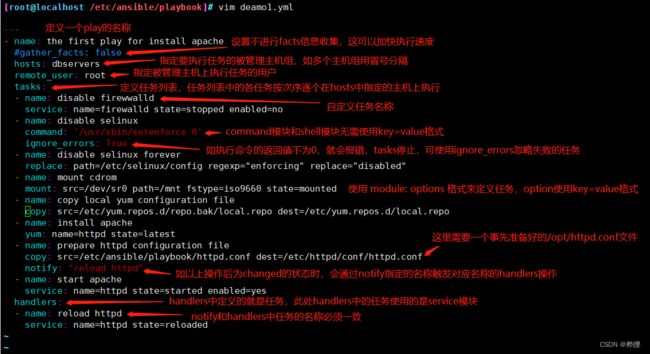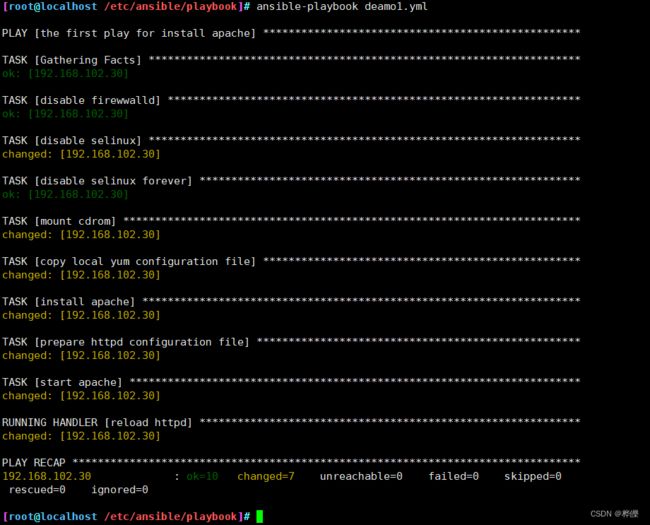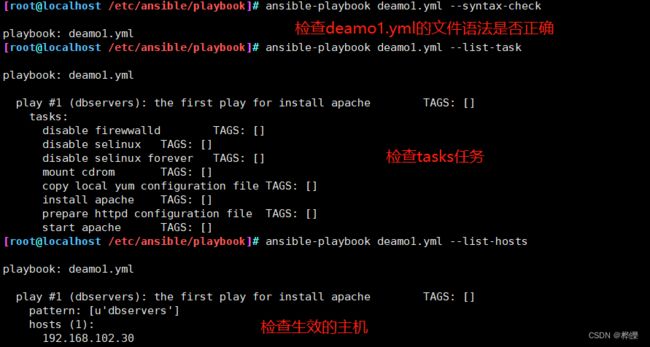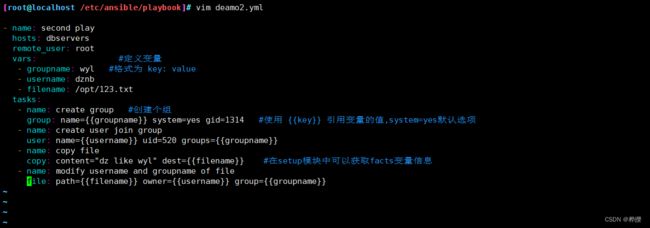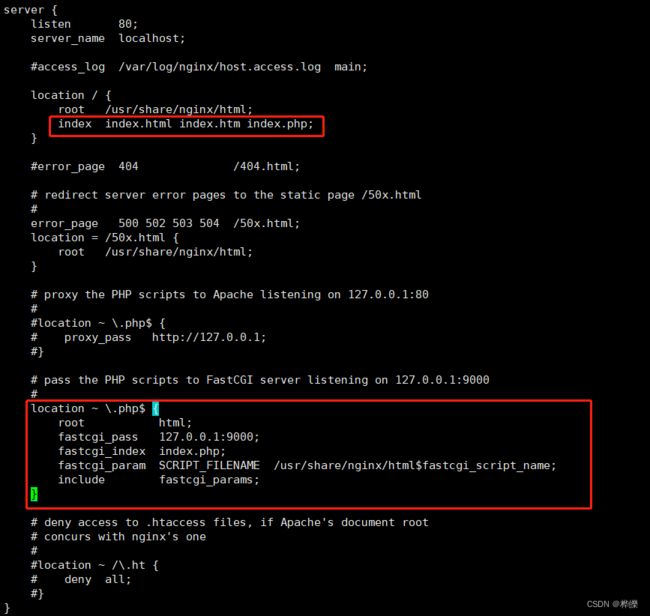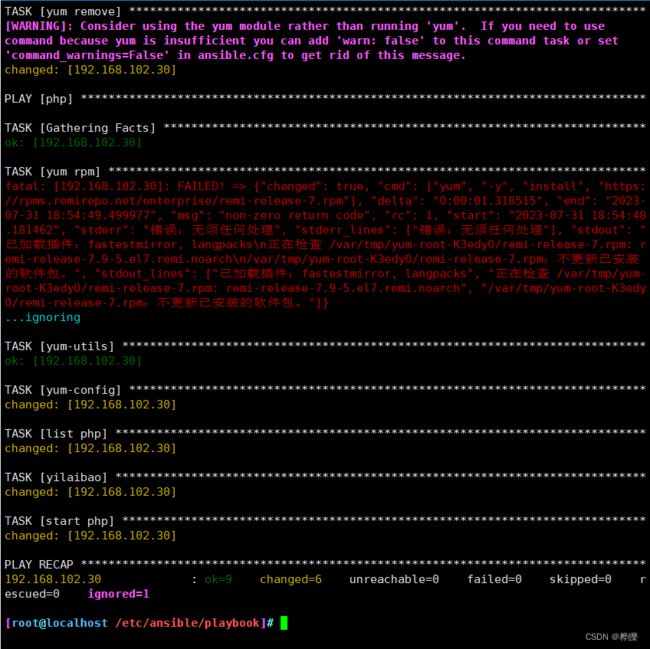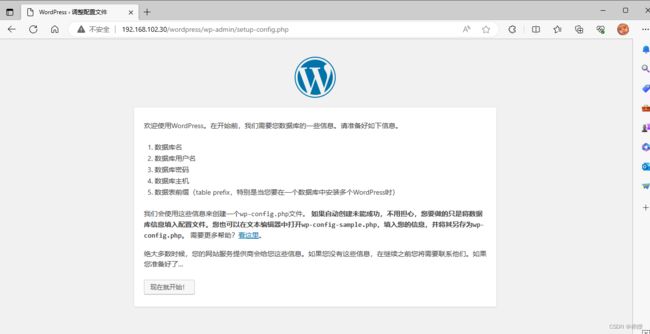- 使用ceph-ansible部署分布式存储Ceph-octopus版本
降世神童
云计算技术专栏分布式cephansible
使用ceph-ansible部署分布式存储Ceph-octopus版本1.Ceph基础概念及部署方式1.1.Ceph基本概念1.2.Ceph部署方式2.系统初始化配置3.Ceph集群部署3.1.Ansible安装与配置3.2.ceph-ansible安装与配置3.2.1.下载ceph-ansible3.2.2.安装ceph-ansible依赖3.2.3.修改ceph配置文件3.3.开始部署ceph
- 全栈运维的“诅咒”与“荣光”:为什么“万金油”工程师是项目成功的隐藏MVP?
云原生水神
职业发展系统运维运维
大家好,今天,我们来聊一个特殊且至关重要的群体:运维工程师。特别是那些在项目制中,以一己之力扛起一个或多个产品生死的“全能战士”。你是否就是其中一员?你的技能树上点亮了:操作系统、网络协议、mysql与Redis中间件、Docker与K8s容器化、Ansible与Terraform自动化、Go/Python工具开发、Prometheus监控体系、opentelemetry可视化,甚至要负责信息安全
- day49-ansible初体验
朱包林
linuxpython运维服务器云计算
1.选型工具说明缺点xshell不适应机器过多场景,需要连接后才能用for+ssh/scp+密钥认证密钥认证,免密码登录scp传输文本/脚本ssh远程执行命令或脚本串行saltstack需要安装客户端ansible无客户端(密钥认证)批量部署环境需要新python版本,被红帽收购了Terraform关注基础设施(云环境),一键创建100台云服务器,一键创建负载均衡,数据库产品2.ansible架构
- 自动化运维工程师实操面试题
以下是针对Ansible、Zabbix、ElasticsearchLogstashKibana(ELK)设计的2道综合实操题,难度适中且结合实际应用场景:实操题1:Ansible自动化部署Zabbix监控平台并集成ELK日志分析题目背景某企业需要通过Ansible自动化部署Zabbix监控服务器(含Agent)、Elasticsearch、Logstash、Kibana(ELK)日志分析系统,并实
- Redhat 9.5 Offline Install Rke2 v1.33.2
文章目录1.版本信息2.节点信息3.系统准备4.配置互信5.安装ansible6.基础配置6.1添加hosts解析6.2文件描述符限制6.3关闭swap6.4安装软件包6.5加载模块6.6设置内核参数7.部署dns8.配置VIP高可用8.1安装nginx8.2安装keepalived9.RKE2集群部署9.1下载软件9.2分发软件9.3初始Master节点安装9.3.1安装rke2-server9
- 自动化工具ansible,以及playbook剧本
自动化工具ansible,以及playbook剧本这篇博客主要说的是,ansible,以及playbook和常用的模块首先先介绍ansibleansible是一个自动化的运维工具,基于python开发主要的功能,可以实现批量的部署程序,批量的执行命令ansible默认通过的是ssh的协议管理机器,无需配置任何服务,管理端部署好后就可以使用。应用的环境应用代码的自动化部署系统管路配置自动化支持持续交
- VPS云服务器自动化运维:Ansible+Puppet实现批量配置管理与监控
cpsvps_net
运维服务器自动化
在云计算时代,VPS云服务器的自动化运维已成为企业提升效率的关键技术。本文将深入解析如何通过Ansible和Puppet两大主流工具实现批量配置管理,构建完整的监控体系,帮助运维团队从重复劳动中解放,确保服务器集群的高可用性。我们将从基础架构设计到实战案例,系统讲解自动化运维的最佳实践路径。VPS云服务器自动化运维:Ansible+Puppet实现批量配置管理与监控一、VPS云服务器自动化运维的核
- 第二十五节:Linux 运维职业规划与学习路径指南
厚衣服_3
Linux基本操作详解运维linux学习
第二十五节:Linux运维职业规划与学习路径指南随着云计算、容器化、自动化运维的快速发展,Linux运维工程师已经成为技术岗位中的重要角色之一。要想在运维领域长期发展,不仅要掌握扎实的基础技能,更要有清晰的职业规划和学习路径。一、Linux运维职业方向概览职业方向技术关键词基础运维工程师Linux、Shell、网络、服务部署、安全配置自动化运维/DevOpsAnsible、Docker、Jenki
- Ansible部署MySQL实操
码农运维知识
运维mysqlansiblemysql
一、Ansible概述Ansible是一款开源的自动化运维工具,由MichaelDeHaan于2012年创建,2015年被红帽(RedHat)收购(收购金额超1亿美元)。它基于Python开发,通过SSH协议实现远程节点管理,无需在被控端安装任何客户端代理(Agentless)。这种设计使其成为轻量级、易部署的自动化解决方案,特别适合批量系统配置、应用程序部署和任务编排等场景。核心特点无代理架构:
- Ansible——lookup,过滤器
凤凰战士芭比Q
Ansibleansiblelinux
文章目录Ansible——lookup,过滤器lookup读取文件lookup生成随机密码lookup读取环境变量lookup读取Linux命令的执行结果lookup读取template变量替换后的文件lookup读取配置文件lookup读取DNS解析的值过滤器过滤器使用的位置过滤器对普通变量的操作过滤器对文件路径的操作过滤器对字符串变量的操作过滤器对JSON的操作过滤器对数据结构的操作过滤器的链
- 【运维】Python与Ansible协同作战:打造自动化服务器配置管理的终极解决方案
蒙娜丽宁
Python杂谈人工智能运维pythonansible
《PythonOpenCV从菜鸟到高手》带你进入图像处理与计算机视觉的大门!解锁Python编程的无限可能:《奇妙的Python》带你漫游代码世界在现代IT运维中,服务器配置管理是一项繁琐但至关重要的任务。手动配置多台服务器不仅耗时,还容易出错。本文深入探讨如何利用Python结合Ansible工具实现自动化服务器配置管理与环境部署。通过Python脚本调用AnsibleAPI,我们可以动态生成配
- Python 解析 Ansible 自动化运维的最佳实践
逻辑混乱的哲学家
运维pythonansible
```htmlPython解析Ansible自动化运维的最佳实践Python解析Ansible自动化运维的最佳实践随着云计算和容器技术的快速发展,自动化运维成为了现代IT基础设施管理的重要组成部分。Ansible是一款流行的开源自动化工具,它以简洁的语法和强大的功能赢得了广大开发者的青睐。本文将介绍如何使用Python解析AnsiblePlaybook文件,并结合实际案例展示最佳实践。什么是Ans
- 单测覆盖率和通过率的稳定性问题,以及POM文件依赖包版本一致性的挑战
Aliano217
Pom单测覆盖率测试覆盖率代码覆盖率
一、单元测试覆盖率和通过率稳定性解决方案1.测试环境标准化管理容器化部署:使用Docker或Kubernetes创建与生产环境完全一致的隔离测试环境,确保操作系统、中间件、数据库版本等配置完全一致。基础设施即代码(IaC):通过Terraform或Ansible自动化部署测试环境,避免手动配置偏差,实现环境快速复现。环境监控:部署Prometheus等监控工具,实时对比测试环境与生产环境的资源使用
- 使用kolla 安装openstack train 版本 单节点
闫晟
openstackdockeropenstack
目录1.准备工作1.1环境准备1.2关闭selinux1.3关闭防火墙(可选)1.4更改hosts2.安装docker容器3.安装依赖4.安装Kolla-ansible5.安装Kolla6.配置OpenStack环境6.1调整kolla-ansible全局配置6.2调整all-in-one配置7.生成密码8.部署OpenStack环境9.使用openstack部署完成1.准备工作1.1环境准备物理
- YAML 数据格式详解
漫谈网络
NetDevOps智联空间pythonyamlyml数据格式
1.YAML概念YAML(YAMLAin’tMarkupLanguage)是一种人性化的数据序列化格式:专注于数据而非标记(与XML不同)使用简洁的语法表示复杂数据结构可读性高,适合人类编写和阅读广泛应用于配置文件(如DockerCompose,Ansible,Kubernetes)2.YAML核心原理缩进表示层级:类似Python,使用空格缩进最小化符号:避免引号、括号等干扰符号数据类型推断:自
- Ansible 简介及部署 基础模块学习 ansible部署rsync 及时监控远程同步
努力的IT小王
Ansible批量管理工具ansible学习云计算linux系统架构
Ansible介绍:Ansible是一个配置管理系统,当下最流行的批量自动化运维工具之一,它是一款开源的自动化工具,基于Python开发的配置管理和应用部署的工具。Ansible是基于模块工作的,它只是提供了一种运行框架,本身没有完成任务的能力,真正操作的是Ansible的模块Ansible的特点:它无需Agent的存在,不需要在客户端上安装客户端软件,并非C/S软件,它是基于SSH协议来远程控制
- Ansible 变量(Variables)
悟生啊
Rocky9ansible
Ansible变量(Variables)一、变量的定义和使用定义:在Ansible中,变量(Variables)是用于存储和管理数据的命名容器。变量可以包含字符串、整数、列表、字典等数据类型。使用变量可以使Playbook更加灵活和动态,方便管理和重用。使用场景:变量在Playbook中广泛用于配置文件路径、用户名、密码、主机名等场景,通过变量的使用,可以轻松调整配置,避免硬编码。定义变量的示例:
- Ansible高级语法应用
Linux技术支持工程师
ansibleansible
Ansible高级语法应用error错误处理handlers触发任务when条件判断1.内存不足关闭服务2.判断系统创建文件3.只给node1安装软件包block任务块loop循环**创建目录****使用循环创建密码**装包for循环模板嵌套for循环模板嵌套for循环2error错误处理默认ansible在遇到error会立刻停止playbook,使用ignore_errors可以忽略错误,继续
- ansible角色功能使用
ansible角色功能使用AnsibleRoles目录和文件的规范主要文件的作用公共Roles仓库(https://galaxy.ansible.com)管理。使用nginx创建roles编写任务模板检查执行结果AnsibleRoles目录和文件的规范自定义AnsibleRole编写playbook调用role使用ansible-galaxy管理Roles在实际生产环境中,为了实现不同的功能,我们
- Ansible 变量
TriAngel灬
自动化运维linux云计算运维
Ansible-变量一、Ansible变量介绍我们在PlayBook一节中,将PlayBook类比成了Linux中的shell。那么它作为一门Ansible特殊的语言,肯定要涉及到变量定义、控制结构的使用等特性。在这一节中主要讨论变量的定义和使用二、变量命名规则变量的名字由字母、下划线和数字组成,必须以字母开头#如下变量命名为正确good_aok_b#如下变量命名为错误:_aaa2_bb保留关键字
- 【商城实战(95)】Ansible自动化运维,开启高效部署新篇章
奔跑吧邓邓子
商城实战运维ansible自动化商城实战高效部署
【商城实战】专栏重磅来袭!这是一份专为开发者与电商从业者打造的超详细指南。从项目基础搭建,运用uniapp、ElementPlus、SpringBoot搭建商城框架,到用户、商品、订单等核心模块开发,再到性能优化、安全加固、多端适配,乃至运营推广策略,102章内容层层递进。无论是想深入钻研技术细节,还是探寻商城运营之道,本专栏都能提供从0到1的系统讲解,助力你打造独具竞争力的电商平台,开启电商实战
- 基于kolla-ansible在openEuler 22.03 SP4上部署OpenStack-2023.2
qlau2007
信息技术创新应用ansibleopenstack
测试环境openEuler-22.03-LTS-SP4-x86_64-dvd.isoVirtualBox,4vCPU,8GRAM,50vDisk。安装时删除/home,SWAP分区,全部空间给/目录。目标是部署OpenStackAll-In-One模式,控制节点+计算节点+存储节点在一台机器实现。系统配置常用工具dnfinstall-ytargit优化SSHvi/etc/ssh/sshd_conf
- 中小型架构
KK溜了溜了
架构需求:1架构网站:zrlogwecenterwordpresscloud2要求:实现两个负载均衡器代理并介入keepalived高可用3实现全站https加密4实现两个web站点5实现nfs服务器存储网站静态资源6实现backup服务器能实时有nfs同步(rersync/lsync)过来的数据实现全网备份功能(rsync)7实现服务器内部共享上网8实现各服务器之间时间同步9实现ansible一
- Ansible 错误处理:确保高效自动化
云攀登者-望正茂
ansibleansible
当Ansible收到命令的非零返回码或模块故障时,默认情况下,它会停止在该主机上的执行,并在其他主机上继续执行。但是,在某些情况下,您可能需要不同的行为。有时非零返回码表示成功。有时您希望一台主机上的故障导致所有主机上的执行停止。Ansible提供了处理这些情况的工具和设置,并帮助您获得所需的行为、输出和报告。Ansible是一款强大的工具,可同时在多台计算机上自动执行任务。然而,与任何自动化工具
- 什么是 Ansible 主机和组变量
云攀登者-望正茂
ansibleansible
Ansible是一款强大的自动化工具,可简化配置管理、应用程序部署和预配等IT任务。其最有价值的功能之一是能够定义变量,从而为不同的主机和组定制剧本。本文将解释Ansible中组变量和主机变量的概念,并通过实际示例说明它们的用法。Ansible中的变量是什么?Ansible中的变量允许您定义可在剧本和角色中重复使用的值。它们使您的自动化流程更具动态性,并能适应各种情况。变量可以在多个位置定义,但两
- 在golang中如何将已安装的依赖降级处理,比如:将 go-ansible/[email protected] 更换为 go-ansible/@v1.1.7
哆啦A梦1588
golangansible开发语言
在Go项目中降级go-ansible从v2.2.0到v1.1.7具体步骤:第一步:修改go.mod文件//原v2版本声明requiregithub.com/apenella/go-ansible/v2v2.2.0替换为://改为v1版本声明requiregithub.com/apenella/go-ansible/v1v1.1.7更新依赖gogetgithub.com/apenella/go-an
- Ansible for Windows 使用指南
葛习可Mona
AnsibleforWindows使用指南项目地址:https://gitcode.com/gh_mirrors/an/ansible.windows项目介绍AnsibleforWindows是一个Ansible集合,专为简化Windows环境下的自动化管理而设计。它提供了一系列模块,让系统管理员能够用Ansible在Windows机器上执行常见任务,如安装软件、配置设置等,无需直接编写复杂的Po
- python 管理windows客户端_使用 Ansible 管理 Windows
weixin_39597868
python管理windows客户端
前言本文主要介绍在如何使用Ansible管理Windows客户端,Ansible官方提供了一个很方便的安装脚本,对于外网用户来说安装真的很轻松,可惜我遇到的问题是如何在内网部署,有相同烦恼的小伙伴不妨参考下轻轻松松使用Ansible管理Windows客户端更新历史2018年05月21日-初稿扩展阅读AnsibleWindowsSupportAnsible在2.3版本之前对于Windows支持的并不
- 怎么用ansible创建证书
三更寒天
ansible服务器apachelinuxhttps
Ansible可以通过使用openssl模块来生成证书。首先,需要定义openssl模块所需的参数,然后将其传递给openssl模块。以下是一个示例:-name:Generatecertificateopenssl_certificate:path:/etc/ssl/certs/example.com.pemprivatekey_path:/etc/ssl/private/example.com.
- 使用 Ansible 在 Windows 服务器上安装 SSL 证书
云攀登者-望正茂
ansibleansible
在本教程中,我将向您展示如何使用Ansible在Windows服务器上安装SSL证书。使用Ansible自动化SSL证书安装过程可以提高IT运营的效率、一致性和协作性。我将介绍以下步骤:将SSL证书文件复制到服务器将PFX证书导入指定的存储区获取导入的证书将证书绑定到网站重启网站运行Ansible脚本先决条件开始之前,请确保您已满足以下先决条件:本地计算机上已安装AnsibleSSL证书文件(.p
- java的(PO,VO,TO,BO,DAO,POJO)
Cb123456
VOTOBOPOJODAO
转:
http://www.cnblogs.com/yxnchinahlj/archive/2012/02/24/2366110.html
-------------------------------------------------------------------
O/R Mapping 是 Object Relational Mapping(对象关系映
- spring ioc原理(看完后大家可以自己写一个spring)
aijuans
spring
最近,买了本Spring入门书:spring In Action 。大致浏览了下感觉还不错。就是入门了点。Manning的书还是不错的,我虽然不像哪些只看Manning书的人那样专注于Manning,但怀着崇敬 的心情和激情通览了一遍。又一次接受了IOC 、DI、AOP等Spring核心概念。 先就IOC和DI谈一点我的看法。IO
- MyEclipse 2014中Customize Persperctive设置无效的解决方法
Kai_Ge
MyEclipse2014
高高兴兴下载个MyEclipse2014,发现工具条上多了个手机开发的按钮,心生不爽就想弄掉他!
结果发现Customize Persperctive失效!!
有说更新下就好了,可是国内Myeclipse访问不了,何谈更新...
so~这里提供了更新后的一下jar包,给大家使用!
1、将9个jar复制到myeclipse安装目录\plugins中
2、删除和这9个jar同包名但是版本号较
- SpringMvc上传
120153216
springMVC
@RequestMapping(value = WebUrlConstant.UPLOADFILE)
@ResponseBody
public Map<String, Object> uploadFile(HttpServletRequest request,HttpServletResponse httpresponse) {
try {
//
- Javascript----HTML DOM 事件
何必如此
JavaScripthtmlWeb
HTML DOM 事件允许Javascript在HTML文档元素中注册不同事件处理程序。
事件通常与函数结合使用,函数不会在事件发生前被执行!
注:DOM: 指明使用的 DOM 属性级别。
1.鼠标事件
属性
- 动态绑定和删除onclick事件
357029540
JavaScriptjquery
因为对JQUERY和JS的动态绑定事件的不熟悉,今天花了好久的时间才把动态绑定和删除onclick事件搞定!现在分享下我的过程。
在我的查询页面,我将我的onclick事件绑定到了tr标签上同时传入当前行(this值)参数,这样可以在点击行上的任意地方时可以选中checkbox,但是在我的某一列上也有一个onclick事件是用于下载附件的,当
- HttpClient|HttpClient请求详解
7454103
apache应用服务器网络协议网络应用Security
HttpClient 是 Apache Jakarta Common 下的子项目,可以用来提供高效的、最新的、功能丰富的支持 HTTP 协议的客户端编程工具包,并且它支持 HTTP 协议最新的版本和建议。本文首先介绍 HTTPClient,然后根据作者实际工作经验给出了一些常见问题的解决方法。HTTP 协议可能是现在 Internet 上使用得最多、最重要的协议了,越来越多的 Java 应用程序需
- 递归 逐层统计树形结构数据
darkranger
数据结构
将集合递归获取树形结构:
/**
*
* 递归获取数据
* @param alist:所有分类
* @param subjname:对应统计的项目名称
* @param pk:对应项目主键
* @param reportList: 最后统计的结果集
* @param count:项目级别
*/
public void getReportVO(Arr
- 访问WEB-INF下使用frameset标签页面出错的原因
aijuans
struts2
<frameset rows="61,*,24" cols="*" framespacing="0" frameborder="no" border="0">
- MAVEN常用命令
avords
Maven库:
http://repo2.maven.org/maven2/
Maven依赖查询:
http://mvnrepository.com/
Maven常用命令: 1. 创建Maven的普通java项目: mvn archetype:create -DgroupId=packageName
- PHP如果自带一个小型的web服务器就好了
houxinyou
apache应用服务器WebPHP脚本
最近单位用PHP做网站,感觉PHP挺好的,不过有一些地方不太习惯,比如,环境搭建。PHP本身就是一个网站后台脚本,但用PHP做程序时还要下载apache,配置起来也不太很方便,虽然有好多配置好的apache+php+mysq的环境,但用起来总是心里不太舒服,因为我要的只是一个开发环境,如果是真实的运行环境,下个apahe也无所谓,但只是一个开发环境,总有一种杀鸡用牛刀的感觉。如果php自己的程序中
- NoSQL数据库之Redis数据库管理(list类型)
bijian1013
redis数据库NoSQL
3.list类型及操作
List是一个链表结构,主要功能是push、pop、获取一个范围的所有值等等,操作key理解为链表的名字。Redis的list类型其实就是一个每个子元素都是string类型的双向链表。我们可以通过push、pop操作从链表的头部或者尾部添加删除元素,这样list既可以作为栈,又可以作为队列。
&nbs
- 谁在用Hadoop?
bingyingao
hadoop数据挖掘公司应用场景
Hadoop技术的应用已经十分广泛了,而我是最近才开始对它有所了解,它在大数据领域的出色表现也让我产生了兴趣。浏览了他的官网,其中有一个页面专门介绍目前世界上有哪些公司在用Hadoop,这些公司涵盖各行各业,不乏一些大公司如alibaba,ebay,amazon,google,facebook,adobe等,主要用于日志分析、数据挖掘、机器学习、构建索引、业务报表等场景,这更加激发了学习它的热情。
- 【Spark七十六】Spark计算结果存到MySQL
bit1129
mysql
package spark.examples.db
import java.sql.{PreparedStatement, Connection, DriverManager}
import com.mysql.jdbc.Driver
import org.apache.spark.{SparkContext, SparkConf}
object SparkMySQLInteg
- Scala: JVM上的函数编程
bookjovi
scalaerlanghaskell
说Scala是JVM上的函数编程一点也不为过,Scala把面向对象和函数型编程这两种主流编程范式结合了起来,对于熟悉各种编程范式的人而言Scala并没有带来太多革新的编程思想,scala主要的有点在于Java庞大的package优势,这样也就弥补了JVM平台上函数型编程的缺失,MS家.net上已经有了F#,JVM怎么能不跟上呢?
对本人而言
- jar打成exe
bro_feng
java jar exe
今天要把jar包打成exe,jsmooth和exe4j都用了。
遇见几个问题。记录一下。
两个软件都很好使,网上都有图片教程,都挺不错。
首先肯定是要用自己的jre的,不然不能通用,其次别忘了把需要的lib放到classPath中。
困扰我很久的一个问题是,我自己打包成功后,在一个同事的没有装jdk的电脑上运行,就是不行,报错jvm.dll为无效的windows映像,如截图
最后发现
- 读《研磨设计模式》-代码笔记-策略模式-Strategy
bylijinnan
java设计模式
声明: 本文只为方便我个人查阅和理解,详细的分析以及源代码请移步 原作者的博客http://chjavach.iteye.com/
/*
策略模式定义了一系列的算法,并将每一个算法封装起来,而且使它们还可以相互替换。策略模式让算法独立于使用它的客户而独立变化
简单理解:
1、将不同的策略提炼出一个共同接口。这是容易的,因为不同的策略,只是算法不同,需要传递的参数
- cmd命令值cvfM命令
chenyu19891124
cmd
cmd命令还真是强大啊。今天发现jar -cvfM aa.rar @aaalist 就这行命令可以根据aaalist取出相应的文件
例如:
在d:\workspace\prpall\test.java 有这样一个文件,现在想要将这个文件打成一个包。运行如下命令即可比如在d:\wor
- OpenJWeb(1.8) Java Web应用快速开发平台
comsci
java框架Web项目管理企业应用
OpenJWeb(1.8) Java Web应用快速开发平台的作者是我们技术联盟的成员,他最近推出了新版本的快速应用开发平台 OpenJWeb(1.8),我帮他做做宣传
OpenJWeb快速开发平台以快速开发为核心,整合先进的java 开源框架,本着自主开发+应用集成相结合的原则,旨在为政府、企事业单位、软件公司等平台用户提供一个架构透
- Python 报错:IndentationError: unexpected indent
daizj
pythontab空格缩进
IndentationError: unexpected indent 是缩进的问题,也有可能是tab和空格混用啦
Python开发者有意让违反了缩进规则的程序不能通过编译,以此来强制程序员养成良好的编程习惯。并且在Python语言里,缩进而非花括号或者某种关键字,被用于表示语句块的开始和退出。增加缩进表示语句块的开
- HttpClient 超时设置
dongwei_6688
httpclient
HttpClient中的超时设置包含两个部分:
1. 建立连接超时,是指在httpclient客户端和服务器端建立连接过程中允许的最大等待时间
2. 读取数据超时,是指在建立连接后,等待读取服务器端的响应数据时允许的最大等待时间
在HttpClient 4.x中如下设置:
HttpClient httpclient = new DefaultHttpC
- 小鱼与波浪
dcj3sjt126com
一条小鱼游出水面看蓝天,偶然间遇到了波浪。 小鱼便与波浪在海面上游戏,随着波浪上下起伏、汹涌前进。 小鱼在波浪里兴奋得大叫:“你每天都过着这么刺激的生活吗?简直太棒了。” 波浪说:“岂只每天过这样的生活,几乎每一刻都这么刺激!还有更刺激的,要有潮汐变化,或者狂风暴雨,那才是兴奋得心脏都会跳出来。” 小鱼说:“真希望我也能变成一个波浪,每天随着风雨、潮汐流动,不知道有多么好!” 很快,小鱼
- Error Code: 1175 You are using safe update mode and you tried to update a table
dcj3sjt126com
mysql
快速高效用:SET SQL_SAFE_UPDATES = 0;下面的就不要看了!
今日用MySQL Workbench进行数据库的管理更新时,执行一个更新的语句碰到以下错误提示:
Error Code: 1175
You are using safe update mode and you tried to update a table without a WHERE that
- 枚举类型详细介绍及方法定义
gaomysion
enumjavaee
转发
http://developer.51cto.com/art/201107/275031.htm
枚举其实就是一种类型,跟int, char 这种差不多,就是定义变量时限制输入的,你只能够赋enum里面规定的值。建议大家可以看看,这两篇文章,《java枚举类型入门》和《C++的中的结构体和枚举》,供大家参考。
枚举类型是JDK5.0的新特征。Sun引进了一个全新的关键字enum
- Merge Sorted Array
hcx2013
array
Given two sorted integer arrays nums1 and nums2, merge nums2 into nums1 as one sorted array.
Note:You may assume that nums1 has enough space (size that is
- Expression Language 3.0新特性
jinnianshilongnian
el 3.0
Expression Language 3.0表达式语言规范最终版从2013-4-29发布到现在已经非常久的时间了;目前如Tomcat 8、Jetty 9、GlasshFish 4已经支持EL 3.0。新特性包括:如字符串拼接操作符、赋值、分号操作符、对象方法调用、Lambda表达式、静态字段/方法调用、构造器调用、Java8集合操作。目前Glassfish 4/Jetty实现最好,对大多数新特性
- 超越算法来看待个性化推荐
liyonghui160com
超越算法来看待个性化推荐
一提到个性化推荐,大家一般会想到协同过滤、文本相似等推荐算法,或是更高阶的模型推荐算法,百度的张栋说过,推荐40%取决于UI、30%取决于数据、20%取决于背景知识,虽然本人不是很认同这种比例,但推荐系统中,推荐算法起的作用起的作用是非常有限的。
就像任何
- 写给Javascript初学者的小小建议
pda158
JavaScript
一般初学JavaScript的时候最头痛的就是浏览器兼容问题。在Firefox下面好好的代码放到IE就不能显示了,又或者是在IE能正常显示的代码在firefox又报错了。 如果你正初学JavaScript并有着一样的处境的话建议你:初学JavaScript的时候无视DOM和BOM的兼容性,将更多的时间花在 了解语言本身(ECMAScript)。只在特定浏览器编写代码(Chrome/Fi
- Java 枚举
ShihLei
javaenum枚举
注:文章内容大量借鉴使用网上的资料,可惜没有记录参考地址,只能再传对作者说声抱歉并表示感谢!
一 基础 1)语法
枚举类型只能有私有构造器(这样做可以保证客户代码没有办法新建一个enum的实例)
枚举实例必须最先定义
2)特性
&nb
- Java SE 6 HotSpot虚拟机的垃圾回收机制
uuhorse
javaHotSpotGC垃圾回收VM
官方资料,关于Java SE 6 HotSpot虚拟机的garbage Collection,非常全,英文。
http://www.oracle.com/technetwork/java/javase/gc-tuning-6-140523.html
Java SE 6 HotSpot[tm] Virtual Machine Garbage Collection Tuning
&
